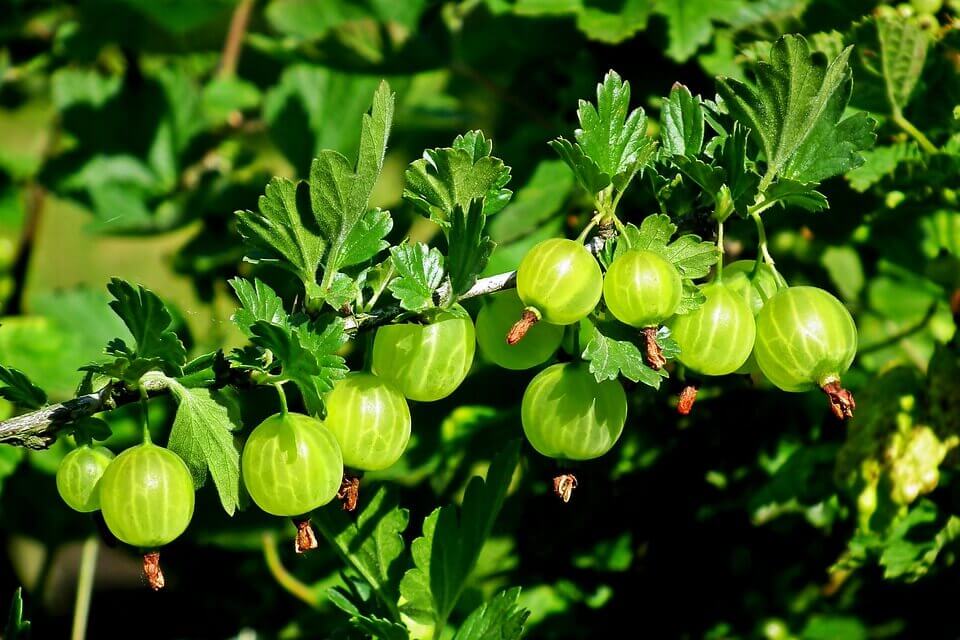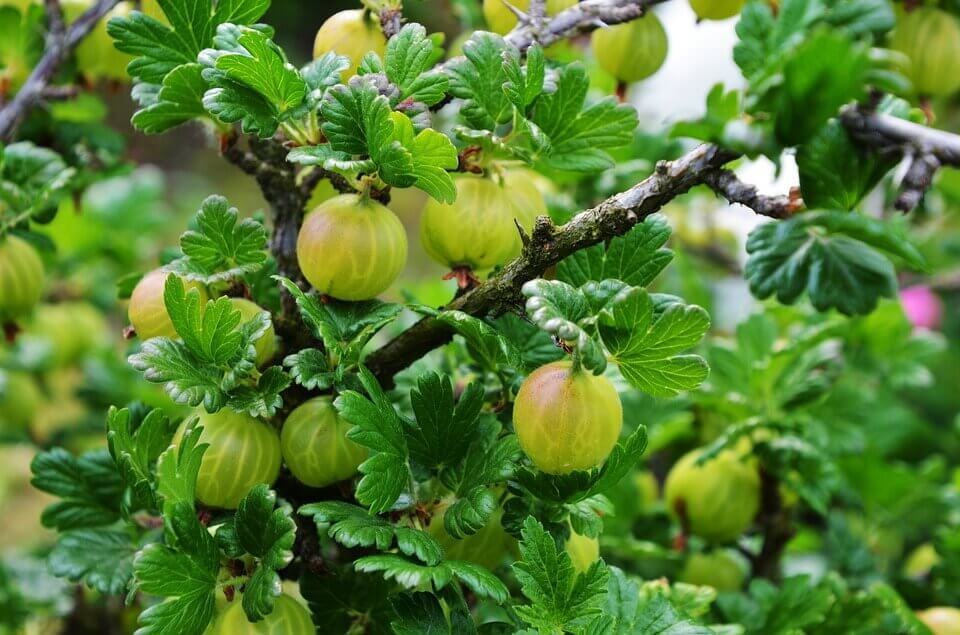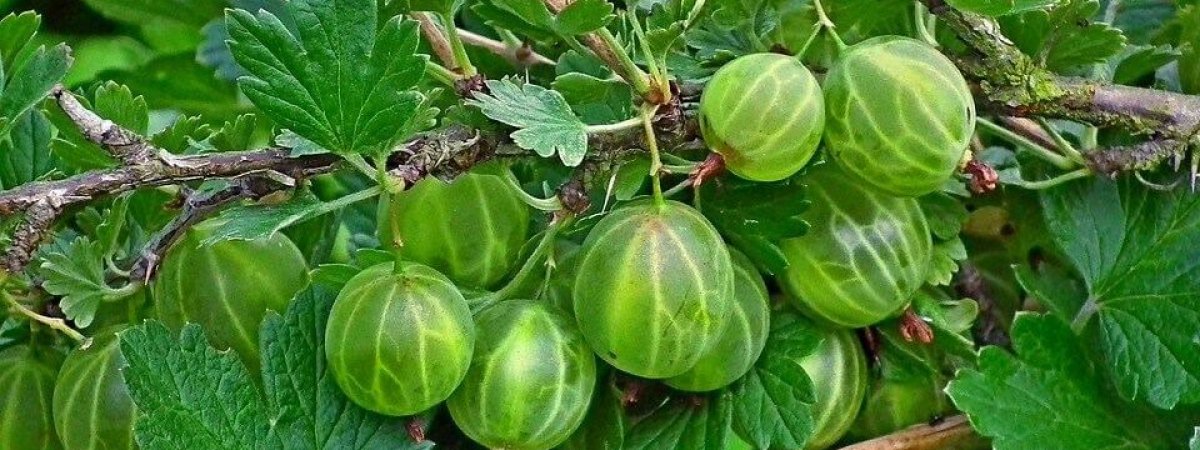Gooseberries are round, small, thin-skinned fruits that are close to grapes in appearance. Ripe gooseberries can be pink, green, white, or yellow. You will come across wide varieties of the fruit when you are learning about how to grow gooseberries.
Some of the varieties are used as desserts and for eating fresh, while others for cooking tarts, jellies, pies, jam, and sauces. There are some which you can use for both fresh-eating and cooking purposes.

Growing gooseberries
Gooseberry is recognized as a deciduous, hardy, and perennial shrub that reaches a height of 4-5 feet, and grows best in winter and summer areas. In winter, they benefit from the cold temperatures that freeze the top inches of soil.
Some varieties thrive in warmer regions. Before you get to the process of growing gooseberries in your garden, let’s discuss the different types of fruit you can choose from.
Types of Gooseberries
You can choose from dessert or culinary varieties. Culinary gooseberries are cooked with sugar to balance their sour taste. They work best in pies, jams, puddings, etc.
Dessert varieties are known for their naturally sweet taste. You can consume them fresh from the bushes. When you know about how to grow gooseberries on your own, you can treat yourself with these sweet little desserts whenever you want!
When growing dessert berries, you can pick some young ones for cooking, and let the others mature to complete sweetness. Typically, both the varieties are pale green, but you can look for attractive yellow or red varieties as well.
Find the right location for growing gooseberries
Mostly, gooseberries thrive in gardens; just select the area with well-drained soil and bright sunlight. The fruit naturally grows into bushes, but can be supported to grow into a long single trunk, against a fence as single-stemmed cordons or fans.
If you don’t have much space to grow gooseberries or there’s just a patio you can spare for the berries, you can easily grow gooseberries in containers!
Note: In some regions of the United States, growing gooseberries is restricted as are known as host to white pine blister rust. It is a disease affecting the lumber industry.
Planting gooseberries
Follow these easy steps of how to grow gooseberries from seed:
- Plant container-grown or bare-root gooseberries sometime between late fall and early spring.
- If the ground in your garden seems freezing over winter, you may have to hold until spring.
- Dig a planting hole, and add well-rotted manure or compost to the planting site.
- Take the gooseberry you chose to plant and keep it in the hole to flush the initial soil level with the current level.
- Put the soil mix around the roots/rootball.
- Firm the soil patiently while filling the hole to anchor the roots.
- Water it to ensure the soil is settled.
- Now add organic mulch to the area to keep away weeds
Note: When growing more than one gooseberry bush, keep them at least 120cm or 4ft apart. You can plant cordons closer, but remember tying the stem to a bamboo cane for support.
Caring for gooseberries
- In the case of moisture-retentive soils, established gooseberry bushes require less additional watering.
- You must continue frequent watering in dry and hot weather conditions for young plants, and container-grown gooseberries as well.
- You can apply a balanced and organic fertilizer every year during late winter as a good start for the next growing season.
- Before adding mulches to the growing area, remove all the weeds around the root (a minimum of 3cm or an inch deep).
- For mulch, use organic elements, such as bark chippings or garden compost.

Pruning gooseberry bushes
You should prune mature gooseberry bushes to promote an open and well-spaced branch structure. It allows a sufficient amount of light and better air circulation to keep away diseases. Mostly, pruning is done when the bush remains dormant in winter.
Here’s how you prune gooseberries:
- Start with removing all the dead or infested wood, overcrowded or tangled branches, and shoots growing close to the ground.
- Prune the remaining branches by cutting off half of the last season’s growth.
- The side shoots arising from the primary branches should be cut to 1 to 3 buds, right from the base of the shoot of the bush.
- Make sure all the cuts are made right above the outfacing facing bud to allow the open growing habit of the established gooseberry bush.
- Dig up the suckers (if any), the stem growing from the ground and moving away from the primary stem.
Harvesting gooseberries
There are times when birds can feed on fruits before you get the opportunity to pick them. The experience is no different while growing gooseberries. You must cover the plant with netting or grow berries inside a custom-built fruit cage.
Gooseberries mature and are ready for harvest from early summer. Harvesting dual-purpose or dessert varieties in phases give under-ripe fruits early for cooking, and later fruits to enjoy raw, sweet and fresh.
One of the reasons to go by phases of harvesting is that the berries left for late picking grow larger. While harvesting gooseberries, you must handle the delicate and plump fruits carefully; wear gloves to prevent the thorns from pricking your hands.
If you eat gooseberries right after you pick them, it tastes the best. However, you can store them in polythene bags and keep fresh for a week in the refrigerator. Alternatively, you can freeze gluts for a better taste of summer.
Possible problems you may face while growing gooseberries
Gooseberry mildew
Gooseberry mildew leads to powdery white and grey fungus on stems and leaves. You may also see the mildew appearing on the fruit, leading to ripening issues.
What to do: You should cut off the infested stems or leaves and destroy them. If you plant the gooseberry bushes close, the mildew gets worse. So, make sure you use the proper spacing technique when growing multiple gooseberry bushes.
Gooseberry sawfly
Pale green larvae appearing like caterpillars cause fast and serious plant defoliation, mostly taking down the bushes to naked stems by the time of harvest. The damage begins sometime around mid to late spring.
You may not be aware, but the pest can be infesting through almost three generations that lead to regular issues till summer.
What to do: Carefully inspect the gooseberry bushes from mid-spring. Check the undersides of leaves and specifically the centre of the bush. If you find any larvae, remove them with hand.
Birds
Yes, you read that right. Birds can be a problem while growing gooseberries, mainly pigeons. They can cause a series of issues like eating buds, seedlings, leaves, and fruits.
What to do: Cover the bushes with fleece or netting to protect against birds. You can also use scarecrows or other bird-scaring techniques, however, the best way remains to cover them up with horticultural mesh or fleece.
Conclusion
Now that you have adequate information on growing gooseberries, why not give the fruit some space in your garden! They are reliable and delicious fruits that deserve acceptance widely. Choose a suitable variety and apply the ways we discussed on how to grow gooseberries above. Let us know how did it go in the comments below!
You may also like to read
How to Grow Apple Trees? Best Ways to Plant and Harvest the Delicious Fruit
How to grow persimmon tree? From Planting to Pruning, All in One Place!






